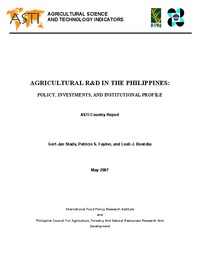Authors:
Stads, Gert-Jan; Faylon, Patricio S.; Buendia, Leah J.
Year:
2007
Publisher
International Food Policy Research Institute (IFPRI); and Philippine Council For Agriculture, Forestry And Natural Resources Research And Development (PCARRD)
Back to:
Agricultural researcher totals in the Philippines have increased gradually over the past two decades. In fact, with close to 4,000 fte researchers in 2002, the Philippines has one of the largest agricultural research systems in Asia. Nevertheless, average scientific qualifications of Philippine agricultural research staff are relatively low: less than half of all agricultural researchers held postgraduate degrees in 2002. In terms of total agricultural research spending, the Philippines ranks behind more economically advanced Asian countries. Nonetheless, agricultural R&D spending in the Philippines has shown significant growth in recent years. In 2002, the country invested $269 million in agricultural R&D (in 2000 international dollars), which is an increase of two-thirds over the level recorded a decade earlier.
The organizational structure of agricultural R&D in the Philippines is highly complex with two separate but closely linked networks existing side by side: NARRDN and the regional consortia. Both systems comprise a large number of national government, regional government, and higher education agencies, each with its own commodity focus and area of responsibilities. What distinguishes the Philippines from many of its Southeast Asian neighbors is the important role the higher education sector (mainly UPLB) plays in agricultural R&D. All four NMCRDCs are based at large agricultural universities, and most of the regional activities of large government agencies,
such as PhilRice and PCC, take place at universities. Despite its intricate and extremely decentralized R&D structure, agricultural R&D in the Philippines is still dominated by the public sector. By our estimates, private-sector agencies accounted for 18 percent of the country’s agricultural R&D expenditures in 2002, which is higher than in most countries in the Asia–Pacific region. This share has actually declined in recent years, due to a more rapid growth in public-sector research spending.
Public agricultural R&D in the Philippines is heavily reliant on government sources of support. In 2002, the Philippine government provided more than 85 percent of
funding to the government agencies. In recent years, however, the share of internally generated resources has gradually increased. Foreign donor support plays only a marginal role in the Philippine agricultural R&D system, distinguishing it from some other countries in the region. In terms of the public-sector intensity of investment in
agricultural R&D, the Philippines rates slightly above the Asian average. In 2002, the Philippines invested $0.46 for every $100 of agricultural output, which was more than 70 percent higher than the equivalent ratio recorded a decade earlier.

